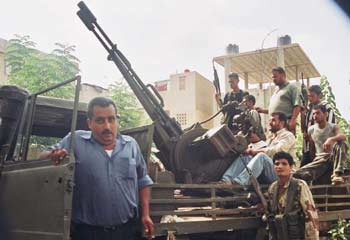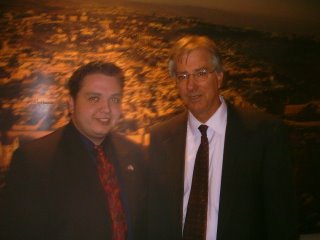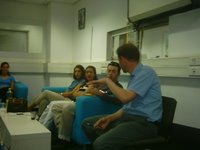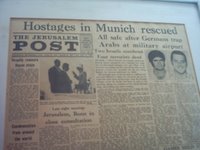Wednesday, August 02, 2006
The effects of Hezbollah terrorism on Israeli Cities: A Monday Morning in Haifa
The above video is the result of Hezbollah terrorists firing missiles at Israeli northern towns like Haifa. Where are these rockets fired from? The answer:
 From mobile missile launch vehicles, they fire rockets on Haifa and much of northern Israel which are distinctly different from the Soviet-built katyushas of earlier wars.Instead of standard military fragmentation warheads, deadly enough, Hezbollah's rockets are packed with thousands of tiny ball-bearings, which burst out from the warhead in every direction like so many bullets.
From mobile missile launch vehicles, they fire rockets on Haifa and much of northern Israel which are distinctly different from the Soviet-built katyushas of earlier wars.Instead of standard military fragmentation warheads, deadly enough, Hezbollah's rockets are packed with thousands of tiny ball-bearings, which burst out from the warhead in every direction like so many bullets.And where are the Hezbollah terrorists before, after and during their rocket launches? The Australian Herald Sun exposes them for what they are:

Suburban warfare: Hezbollah fighters are ready for action in a residential area.
Thursday, July 20, 2006
My letter to the Editor in Minnesota
The letter can be found at the following address: http://www.startribune.com/563/story/539582.html
Israel's plan: It does want peace
In response to the July 6 letter "Israel's long-term plan: It's not about peace," I think that the author is unaware of some basic facts. First, Israel does want peace, and it demonstrated that last summer when it unilaterally disengaged from the Gaza Strip. Israel continues to demonstrate this by sending humanitarian aid and medicine into the Gaza, yet the Hamas-led government has time and again refused Israel's offers of peace.
Second, the writer claimed that Israel holds Palestinian women and juveniles in prison, but he did not mention they include 64 women and 91 juveniles who, according to Israeli Prison Authority Spokeswoman Orit Stelster, have thrown Molotov cocktails at Israeli civilians, transported knives into Israel in order to stab ordinary Israelis, and have been associated with terror organizations like Hamas and Islamic Jihad. These are dangerous people.
Third, the writer says the terrorists are holding only one Israeli soldier, but he doesn't mention that the terrorists attacked inside of Israel and kidnapped Cpl. Gilad Shalit while still firing Qassam rockets into neighboring Israeli towns. Just as the U.S. government is pledged to secure life, liberty and the chance to pursue happiness for us, so must Israel's government guarantee that its citizens will be secure and free.
If the Palestinians stopped terror, Israel would have no reason for curfews, fences, checkpoints and other defensive measures.
VITALI GUERON, ST. PAUL
Israel's plan: It does want peace
In response to the July 6 letter "Israel's long-term plan: It's not about peace," I think that the author is unaware of some basic facts. First, Israel does want peace, and it demonstrated that last summer when it unilaterally disengaged from the Gaza Strip. Israel continues to demonstrate this by sending humanitarian aid and medicine into the Gaza, yet the Hamas-led government has time and again refused Israel's offers of peace.
Second, the writer claimed that Israel holds Palestinian women and juveniles in prison, but he did not mention they include 64 women and 91 juveniles who, according to Israeli Prison Authority Spokeswoman Orit Stelster, have thrown Molotov cocktails at Israeli civilians, transported knives into Israel in order to stab ordinary Israelis, and have been associated with terror organizations like Hamas and Islamic Jihad. These are dangerous people.
Third, the writer says the terrorists are holding only one Israeli soldier, but he doesn't mention that the terrorists attacked inside of Israel and kidnapped Cpl. Gilad Shalit while still firing Qassam rockets into neighboring Israeli towns. Just as the U.S. government is pledged to secure life, liberty and the chance to pursue happiness for us, so must Israel's government guarantee that its citizens will be secure and free.
If the Palestinians stopped terror, Israel would have no reason for curfews, fences, checkpoints and other defensive measures.
VITALI GUERON, ST. PAUL
Wednesday, June 28, 2006
Strategic Land: The Golan Heights

My tour of the Golan Heights started by my tour bus driving due east, into the West Bank, passing through the Judean Dessert and the Palestinian town of Jericho. After that we headed due north, driving along the Jordan River and other small towns in Israel until we reached the Sea of Galillee, or Kinneret. From there we went around the Kinneret from the right side, passing tourist-dependent kibbutzim like Ein Gev and others. North of the Kinneret, we passed through the Israeli town of Rosh Pina and Kiryat Shmona, until we reached Misgav Am, a kibbutz located on the Israeli northern border with Lebanon. "There is no Lebennese police here," said Arie, our speaker from the kibbutz, as we sat at an outlook overlooking Southern Lebanon's hills and valleys where small villages and cities are scattered along this scenic view which is also one of the most voletile border. "Its like the Wild West," continued Arie, "Hezbollah (The Syrian Terrorist group) controls the villages here. Look below at the village...you can see the yellow Hezbollah flag at the entrance of the village." As Arie was showing us the geography of southern Lebanon, a UN helicopter flew by, completing its first out of two daily flights over the border to make sure there is no violence. Before Israel left souther Lebanon during the late '90s, Kibbutz Misgav Am enjoyed the buffer created by the Israeli military presence in souther Lebanon, but now they are at the forefront of Hezbollah's vicious barrage of rockets and mortarts it fires into Israel, especially at the naighboring towns of Kiryat Shmona and Metula.

After completing the sceenic visit of Kibbutz Misgav Am, we learned about the attack on the Kibbutz by Hezbollah terrorists after an Army incident involving a storm and the electric sensors of the border fence failing to alert the Kibbutz about the approaching Hezbollah attackers cutting into the fence, killing the secretary of the Kibbutz, two soldiers and a child in the childrens' house. The story was the first of so many stories yet to come.

We then travelled through the Golan Heights, passing Mt. Hermon, at its peak it being the tallest point in Israel where Israelis flock to go skiing in the winter, we arrived at Kibbutz El-Rom, the home of El-Rom studios, where we watched the movie OZ 77 about the 1973 Yom Kippur War. Then we drove down to a lookout point on Mt. Bental, where we were shown views into Syria, and the fertile Golan Heights filled with winneries and orchards of plums, apples, and cherries. On top of Mt. Bental were also sculptures of monsters, animals and obscure figures.
Tuesday, June 20, 2006
Jerusalem Tour: The Security Barrier

ON THIS HOT DAY in Jerusalem, I decided to join a group tour of the seamline of Jerusalem. The seamline is the bondary that separates the neighborhoods in Jerusalem from the suburbs of Jerusalem. After 1967, when Israel annexed a greater Jerusalem, which included the Old City, Gilo & Har Homa to the south, and past Neve Ya'acov and Ramot to the north, the city also gained several Arab neighborhoods, like Beit Hanina to the north and Sur Baher to the south, including smaller villages in East Jerusalem. We first visited Gilo, which was not built up right after the land was annexed but rather in the past decade. It wasnt't until the second intifada that Gilo was hit by mortars and sniper fire coming from accross the valley in Beit Jala and Bethlehem.

WE WERE INFORMED by Miri Eisen, a former IDF Colonel, that Palestinian snipers would shoot from the courtyard of the Church of the Nativity in Bethlehem at Gilo houses, synagogues and kindergardens. Tha's why Gilo residents demanded that a cement wall be put around the neighborhood to protect the houses and buildings on the edge of the cliff overlooking the valley that separates the Jerusalem manisipality from Beit Jala and Bethlehem.

THIS IS where Israel is finishing to build the separation barrier, wall, or fence depending on the language you use. The residents of Gilo painted their cement blocks with various scenic views and happy images to replace the views lost because of the Palestinian sniper fire. Then we went to Har Homa, which is a newly buit and still being finished area of Jerusalem where the security barrier is a series of fences with gates for farmers to harvest their olive trees. The barrier has saved lives and as a result of the barrier, the number of suicide attacks have dropped significantly.

NEXT WE traveled to the Qalandiya Checkpoint, where we stood before the actual checkpoint and looked into the road to Ramallah, where yellow Palestinian taxicabs differing from the usual white Israeli taxicabs were lined up to transport Palestinians from Ramallah to the checkpoint where they could cross by foot. Then after the crossed by foot, they could get into a car and exit the checkpoint with a final check before entering the manisipality of Jerusalem.

FINNALY WE MADE it to the Nabil Samwil, or the tomb of the prophet Samuel, where there is a synagogue which used to be a mosque and church befoere being annexed by Israel. It was a really sunny and clear day! From the roof, we could see to the south the Gush Etzion block mountains next to Bethlehem and to the north the neighboring Palestinian village of Jib (Israeli side of the barrier) and the settlements of Har Shmuel and Givon Hahadasha, both with the distinctive red roofs of the Jewish homes. We were also next to the intersection of the Jerusalem neighborhood of Ramot and the Palestinian village of Beit Iksa, where it is only separated by a small valley, yet one is in Israel as a part of Jerusalem and the other is a small village in the West Bank. The Israeli Surpeme Court ruled that the barrier will be in that valley to leave Beit Iksa inside the West Bank.
Monday, June 19, 2006
Lethal Narratives: Culture of Terror & Martyrdom

Last night I had a chance to attend a lecture by three distinguished women who came from completely different backgrounds and from different countries. The featured speaker, presented by The Israel Project, was Nonie Darwish, a Egyptian born Muslim who's father was the head of the Fedayeen terrorist group in Gaza before the 1967 Six-Day War where Israel captured the Gaza Strip from Egypt.
Because of her father's activities with numerous terror attacks on Israel, Nonie's father was the first to be assasinated by an IDF targeted killing in Gaza. Even Nasser, Egypt's then-president mentioned her father as a "shaheed" (martyr) at the opening of the Suez Canal. Later she and her siblings were asked by the Egyotian Government which of them would avenge their father's death. Nonie moved to the United States and started a Christian family and only went back to Egypt in the early 1990s when her brother was sick and needed an operation.
When she asked where to bring her brother, all Egyptians told her that if she wants her brother to live, she should bring him to Hadassah Hospital in Israel. That, she said, was the turning point for her to be very supportive and thankful to the State of Israel but she was still too afraid to speak out against Muslim extremists,as a mederate Arab woman herself. It was on September 10, 2001 that she and her family returned from the first trip back to Egypt since the '90s, and she saw at radical Islam had taken over her country while Armenians, Koptics and other groups were being driven out. When she woke up on September 11, 2001 and saw the second plane hit the World Trade Center, she knew that Jihad had come to America. It was then that Nonie gained her courage to speak out against radical Islam.
Nonie, along with her daugher Shirene maintain a website for moderate Muslims called ArabsforIsrael.com which serves as an outlet for moderate voices around the Arab world to share their dislike of Islamic extremism and show support for Israel's right to exist as a Jewish State. The event was covered by the media and Nonie was photographed countless times. Nonie was also interviewed by Israel Channel 1 and then was invited to the Presidential House by Israeli President Moshe Katzav. Nonie was featured in an Honest Reporting film called Obsession, which dealt with radical Islam's global war against the west. While the movie was OK, it was Nonie's moving speach that mede people come to her and thank her for showing them what really is going on in the Islamic world.
The other two speakers were Nidra Poller, an author and expert on Islamic extremism living in France, and Isabel Kershner, Middle East Editor of The Jerusalem Report, who made alyah from Europe and shared with the public her interesting meetings with Hamas leaders. The event was very good and attended very well.
This is the movie "Obsession" about radical Islam that Nonie Darwish stars in:
Sunday, June 18, 2006
Start of a new week!

After spending a nice and relaxing weekend in the Yaffo part of Tel Aviv-Yaffo, I became recharged for some more events to progress my goals to make as much Hasbara for Israel while I am here in Jerusalem. While there are many Israelis here partaking in the "mondeal" (the world cup) soccer matches every night, there are just as many journalists who come from their own countries and have very limited knowledge of what the situation here really is and while I don't claim to be an expert or anything on issues such as solving the Israeli-Paletinian conflict or how to stop Iran from aquiring nuclear weapons, I am hopeful that I can atleast work to familiarize myself with some foreign journalists working in Israel and work with them so that I can read their stories in the future without asking myself why their lack of knowledge is so obvious to me and not to anybody else. My task continues...
Thursday, June 15, 2006
We're just getting started!
 AFTER MEETING Ambassador Dennis Ross last week at the Israeli Embassy in Washington DC, along with other Israeli officials, we all arived at Beit Gesher to stay for 2 months. Now that we're settled in, its time to get to work! Anyone who's interested in more personalized details of my experiences, please feel free to e-mail me at this e-mail address vitali002@gmail.com
AFTER MEETING Ambassador Dennis Ross last week at the Israeli Embassy in Washington DC, along with other Israeli officials, we all arived at Beit Gesher to stay for 2 months. Now that we're settled in, its time to get to work! Anyone who's interested in more personalized details of my experiences, please feel free to e-mail me at this e-mail address vitali002@gmail.com I had the chance to visit the BBC's Jerusalem Bureau near the central bus station in Jerusalem, where I met the Middle East Bureau Chief Simon Wilson. Simon's duties are quite challenging because he has also the responsibility of coordinating the reporters in Iraq and elsewhere in the middle east unlike other internation news agencies like CNN.
I had the chance to visit the BBC's Jerusalem Bureau near the central bus station in Jerusalem, where I met the Middle East Bureau Chief Simon Wilson. Simon's duties are quite challenging because he has also the responsibility of coordinating the reporters in Iraq and elsewhere in the middle east unlike other internation news agencies like CNN. 
Speaking of CNN, I also had the chance to visit with Tom Fenton, the CNN Bureau Chief in Jerusalem since 2003, who's leaving at the end of the summer for his native London. Tom spoke about the security training he madates for all the CNN correspondents and the various task the get assigned to do. He also talked about the recent kidnepping of a CNN journalist and also about coming close to being kicked out of the country for airing an interview he should have not made. Tom eplained about the major CNN bureaus in the Middle East including Beirut, Cairo, Amman, Dubai and now Baghdad. Visiting both the BBC and CNN was trully an amazing experience.
End of Week One! Tel Aviv here I come..............

SO THIS WEEK is over and I am going to Tel Aviv for Shabbat and the weekend but before I leave, I would like to share with you my experiences this week.

We had a tour of The Jerusalem Post, where we met the editor David Horowitz, features editor Ruthie Bloom and managing editor Steve Linde.

They all talked about the process of producing The Jerusalem Post, including the daily version, the international weekly version, the French version, the Christian version and the children/teens publication version.

We also saw a Jerusalem Post headline from the Munich Olympics where the headline said that all but two Israeli hostages were saved, even though the next day that proved to be false. Then we saw the press where they used to print the paper until the owner moved it to another location about a year ago.
